
Deposition Date
2000-01-15
Release Date
2001-01-12
Last Version Date
2024-11-20
Entry Detail
PDB ID:
1DXR
Keywords:
Title:
Photosynthetic reaction center from Rhodopseudomonas viridis - His L168 Phe mutant (terbutryn complex)
Biological Source:
Source Organism:
RHODOPSEUDOMONAS VIRIDIS (Taxon ID: 1079)
Host Organism:
Method Details:
Experimental Method:
Resolution:
2.00 Å
R-Value Free:
0.21
R-Value Work:
0.19
R-Value Observed:
0.19
Space Group:
P 43 21 2


